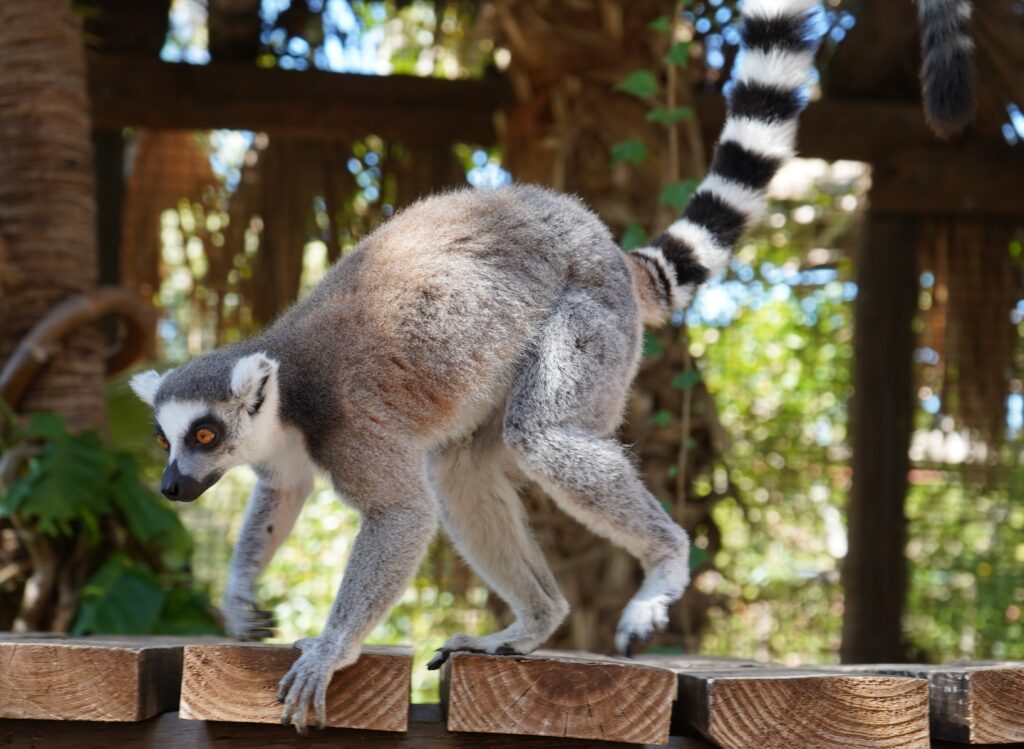RING-TAILED LEMUR
Lemur catta

LENGTH

1 m
WEIGHT

2,5 kg
LIFESPAN

20 years
The ring-tailed lemur is a species of strepsirrhine (wet-nosed) primate of the family Lemuridae. It is the most internationally recognized lemur species due to its appearance.
General characteristics
This species is a relatively large type of lemur. The total length is about 1 meter, but the tail is longer than the body and can be measuring up to 60 cm.
They have a slender body and narrow face with a fox-like snout. The most distinctive feature, a long bushy tail, is banded in alternating black and white transverse bands totaling 12 or 13 white rings and 13 or 14 black rings, and always ending in a black tip. The tail is not prehensile and is used as an aid to balance and for communication and group cohesion.
The fur is dense, with the ventral area and throat being white or cream colored and the dorsal area varying from gray to pinkish brown. On the white face, their eyes are bordered by black triangular spots.
Their toes are slender, padded, mostly membraneless and semi-dexterous with flat, human-like nails. The thumb is short, non-opposable and widely separated from the other fingers.
Feeding
The ring-tailed lemur is an opportunistic omnivore that feeds primarily on fruits, leaves (particularly those of the tamarind tree), flowers, bark and sap. Although they have also been observed eating small insects, arthropods and vertebrates.
Behaviour
The ring-tailed lemur is a highly social species that lives in groups of up to thirty individuals and in which social dominance of the females is evident. To conserve warmth and reinforce social bonds, the groups gather and groom each other.
They are strictly diurnal animals. They like to sunbathe and sit upright on their tails. This is an activity that is done especially in the mornings as a group to warm up. Like other lemurs, they have a great sense of smell and mark their territory with scent glands.
It is one of the most vocal primates and uses numerous vocalizations, such as group cohesion and alarm calls.
Reproduction
The breeding season is usually between April and May. Mating usually occurs between individuals of the same group. Females stagger their receptivity to reduce competition for male attention.
Gestation lasts approximately 135 days and calving occurs in September or, occasionally, in October. In the wild, a single calf is usually born, although there are cases of double births.
When the offsprings are born, the mothers hold them ventrally for a couple of weeks and then carry them on their backs.
Threats
The wild population of the ring-tailed lemur is in danger of extinction due to deforestation, fires, urban development, overgrazing by livestock and logging that have destroyed most of its natural habitat. In addition, local hunting and exotic pet trade have also contributed to the extinction of the species.
Distribution
They are endemic to southern and southwestern Madagascar and live in deciduous forests, dry scrub, montane rainforests and gallery or riparian forests.

Did you know?
They do not see in color and do not have good general vision.
They are considered arboreal, although they spend a lot of time on the ground as well.
The species name, catta, was for their feline appearance and purring vocalization that is similar to the cat´s.
Conservation status
